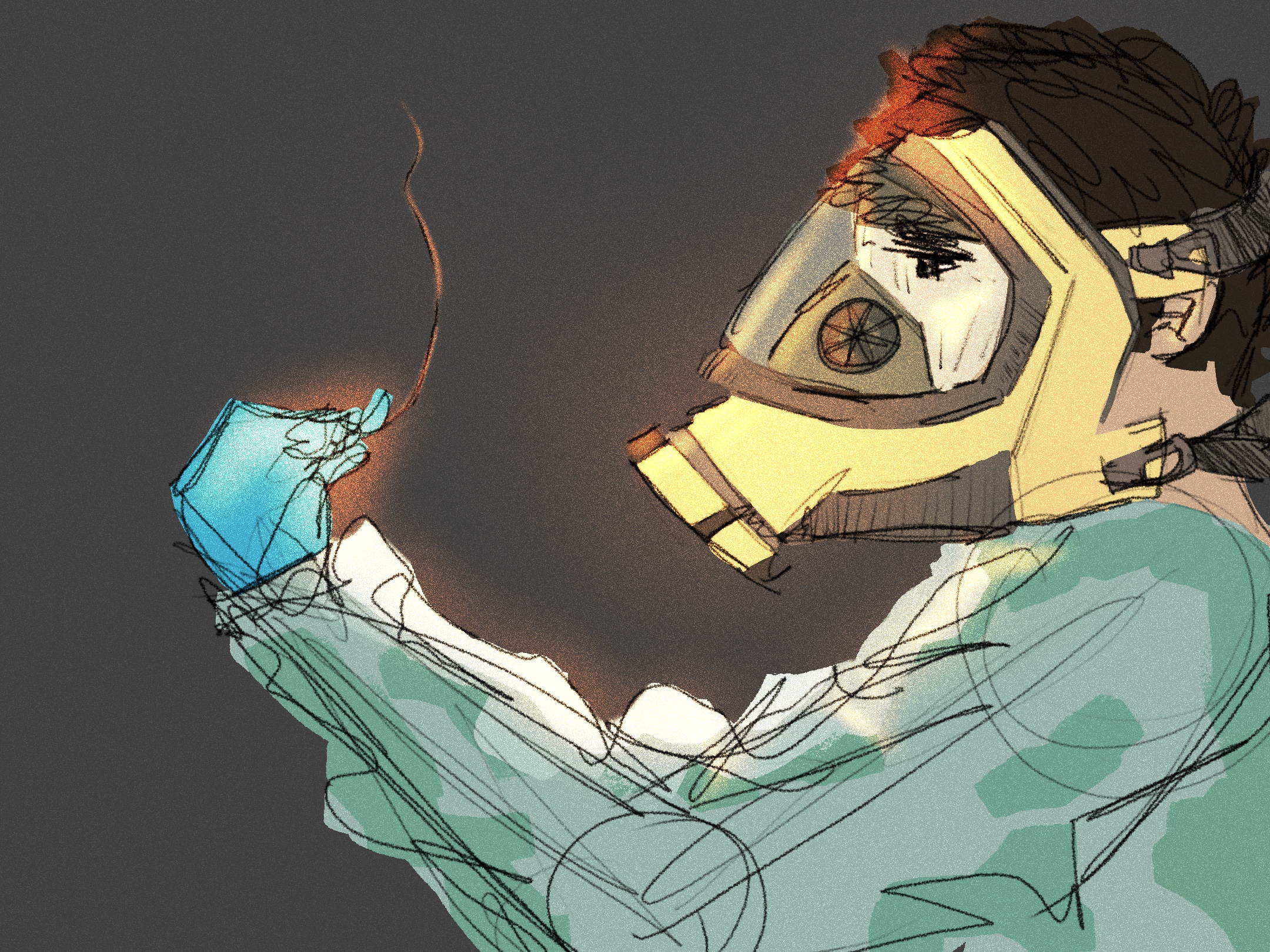It’s Just Hair

art by Willow Street
It started with a single hair.
And not even a particularly remarkable one, according to Melinda Parker and her husband George. They were the first to encounter the hair, though both adamantly denied ownership.
“It was unassuming,” she said when asked about first impressions. “You know, light brown, a little bit of wave. Couldn’t have been more than a foot long.”
“It wasn’t even shiny,” George added. “Looked like it could have fallen right off of one of Pickles’—that’s our cat, a full-blooded Abyssinian—toys. If it wasn’t for Mel, I probably would have just swept it up with the rest of the trash.”
The hair didn’t stay unassuming, however. Nor did it remain under a foot long. When police found the Parkers, just three weeks after the article about their miraculous, ever-growing guest appeared in the St. Juniper Weekly Review, the hair was measured at forty-three feet, six inches. Not including, of course, the twenty-nine and thirty-three foot segments found inside Melinda and George, respectively.
*
Some people claimed it was a hoax. Or that the Parkers were overzealous members of a naturalist group, one which emphasized minimizing waste and reusing resources.
But the medical examiner, Dr. Ashram, rejected these claims. In his report, submitted posthumously by his assistant, he explained that Melinda and George Parker did not consume a collective twenty-two pounds of hair. Nor was it later forced into their systems by an outside party after their deaths. It had grown there, slowly enveloping their muscles, tissues, and organs. Death most likely occurred when they became unable to take in enough nutrients.
Dr. Ashram did not, however, offer any suggestions as to how the hair was able to reproduce inside their bodies.
*
One hundred and sixteen St. Juniper residents died before the mayor requested federal assistance. Another seventy-nine succumbed before the request was approved. By the time troops arrived some four weeks later, it was too late. Cases had been reported in Calhoun, LaPorte, Eccleston.
And the original hair, last measured at one hundred and fourteen feet, nine inches, had escaped. This was hardly a surprise, since the police and medical examiner’s office bore the brunt of the casualties. Contact, it seemed, was crucial to the transmission of Toxic Hair Growth Syndrome.
But not automatically lethal.
Not everyone who came into contact with the hair or its offshoots developed THGS. This led to renewed speculation over its origins. Was it a bioweapon, developed to target only certain members of the population? Was it a form of new, hyper-specialized predator? Was it an alien scout, sent to weed out all but the most suitable servants prior to an invasion?
*
Hair Zero, as it came to be called, was not unique. All hair produced via THGS proved capable of independent locomotion, sometimes within minutes of a host’s death.
This led to many attempts to burn THGS victims and their homes. It also, consequently, led to the improbable discovery that THGS hair was not flammable.
Nor was it meltable, cuttable, or freezable.
In fact, direct assaults appeared to have no effect whatsoever. Except in one unsubstantiated report where a Pellagio man claimed to have fended off several hairs using a homemade hairspray cannon.
He sold a hundred thousand in less than twenty-four hours.
*
The Parkers died in May. By the end of July cases of THGS had been reported in every state.
Whole regions were quarantined.
International travel was suspended.
It didn’t matter.
New hairs continued to appear. Even in places that had little or no contact with outsiders.
Thousands died.
Millions.
The last time someone bothered to count, total deaths were estimated to be around 4.6 billion.
And then it stopped.
Not all at once. Not in a grand, dramatic moment of overwhelming peace. But slowly. Gradually. The massive burial pits became modest mounds. The mounds became piles. The piles became individual, though still unmarked, graves. And, finally, untreated illness reclaimed its seat on the cause of death throne.
The hairs were still there, of course, rolling around in groups of tire-sized bundles. But contact no longer seemed to be an issue.
Survival of the fittest, people told themselves, wasn’t just a concept found in dusty old textbooks.
*
Scientists, however, could find no significant physiological commonalities among survivors. There was no anti-THGS gene, no hair-inhibiting enzyme. Occurrences of baldness were the same as in pre-THGS populations.
So what, then, made some people resistant?
One group of researchers, based out of the New New Institute for Thought in Gardenia, suggested the difference was psychological.
“Look at the Parkers,” Dr. William Ko said in an interview published on whatnow.net. “Melinda had been laid off from her job of twenty-three years less than two months before the incident. George hadn’t worked for almost a decade due to a work-related injury. According to neighbors, their arguments were frequent and loud. Melinda had taken to drinking. In other words, they were in poor mental health.
“And it wasn’t just them. More than ninety percent of the THGS victims with available profiles exhibited behaviors consistent with significant levels of mental distress. It can’t be a coincidence.”
Others criticized their conclusions for being based on skewed data.
“Of course, most of the victims in their study had mental health concerns,” said Angela Rivera, former Editor in Chief of PHI Quarterly, in a scibuzz.com essay. “All but twelve of the records used in their study came from St. Juniper, and more than eighty percent of those cases involved first responders, a group known to have elevated levels of emotional distress.”
And yet others believed it was a person’s social status, not mental health, that affected their immunity to THGS.
“Come on,” said TeeSpiller, the only content creator to ever hold the highest ranking on FreeSpeak, Dribbler, and Shout simultaneously. “It’s obvious, isn’t it? Just look at your new neighbors. I mean, really look.
“Notice anything? They’re all the same, man. All the fucking same. The weirdos, the outcasts, anyone that was seen as even the slightest bit different – they’re all gone.”
*
The more time that passed without an instance of THGS, the less people cared about why it happened.
It was a freak accident. Evolution gone momentarily awry. A sad but closed chapter in human history. Why spend time worrying about it when there are so many things that need to be addressed, here and now, by those who are still alive?
Like, for example, how to rebuild an infrastructure designed to accommodate a population more than double its size.
The president had quite a few ideas about this. As did the astounding three hundred and twenty-three remaining members of Congress. But without the military, local law enforcement, and courts to back them up, no one paid them much attention.
Because, really, how could you trust someone who hadn’t been there when you needed them most?
*
A loose network of city-states formed. This wasn’t so much a collective decision, as a function of the reality that no one could agree on the best course of action. So people settled into groups with likeminded people. Elected – or fell into step behind – leaders whose beliefs mirrored their own.
It worked.
For almost six years.
Until a Purple City woman, fleeing from a group of heavily armed Hope Eternal soldiers after a failed trade negotiation, collapsed near one of the hair gangs just outside the state’s borders.
By the time the soldiers caught up to her she was already sprouting. Strands of dirty blond hair protruded from her mouth, her nose, her eyes.
One of the infantrymen, a fourteen-year-old named Clarity, streamed her slow, hours long death under the title, “Where’s your immunity now, thief?”
The next day he was dead.
*
Speed of onset wasn’t the only difference between the new variant of THGS and the original. THGS-HE was far less selective. Of the self-reported 460,000 residents of Hope Eternal, only 27,000 survived. That represented a shift from a forty-two percent survival rate to one of less than six percent.
Conversations, once again, became dominated by speculation.
Were the hairs really a natural occurrence?
Had we done something to make them more aggressive?
Could we ever truly be safe?
The answer, apparently, was no.
Physical barriers did nothing. Preemptive culling only left fewer hands to dig graves. Sacrificial offerings attracted only insects.
Apex Nation fell.
Starlight Consortium.
Gaia Valley.
Yet the hair tumbled onward, as silent and relentless as ever.
*
Shell City was the last hold out against THGS-HE.
Some thought this was a function of its remote mountaintop location. Others felt it had more to do with the nature of its small, deliberately passive population.
Its residents offered no opinion.
They were too busy taking last-minute notes and organizing files.
Even as their neighbors died, strangled screams in their throats, they worked.
Cataloguing medical data. Annotating incomplete historical records. Recording each and every moment until their swollen bodies could no longer move.
All in the hope that, next time, maybe someone would actually bother to listen.


